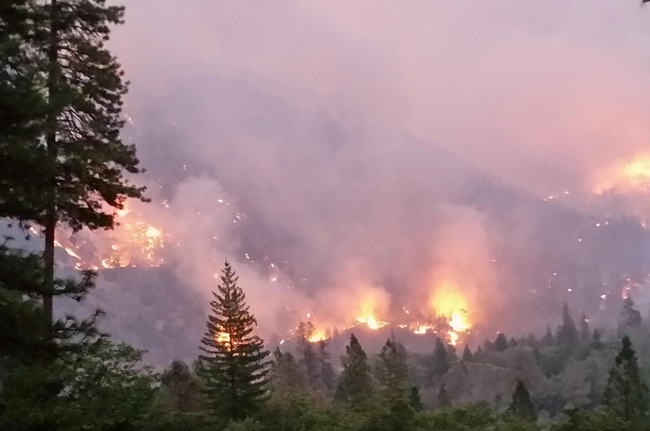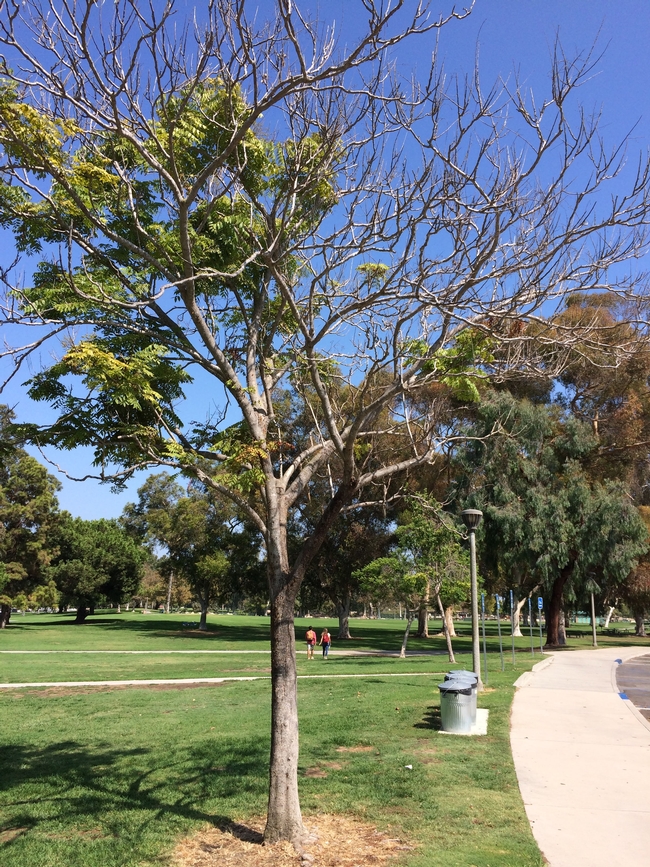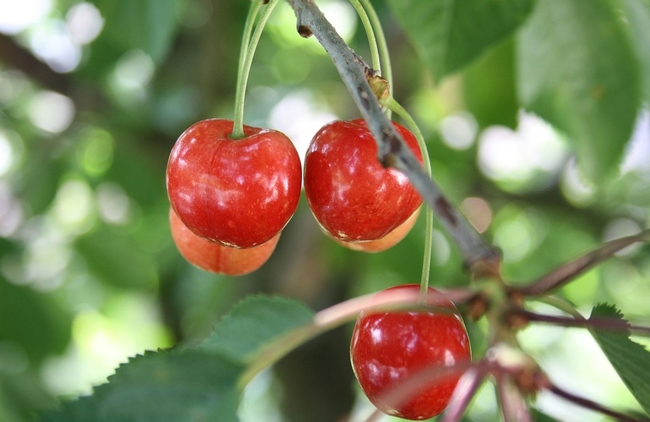Posts Tagged: Climate Change
Climate change is converting cities into 21st century ghost towns
In California, most ghost towns were created when a local industry collapsed. Now, climate change is more often to blame when booming communities whither and die, reported Daniel Cusick in E&E News.
In an eerie horror story released just before Halloween, Cusick wrote about five towns around the nation that have died or are dying from climate-related disasters. Historic Shasta and Helena, Calif., are featured in one of the vignettes.
"Those are two towns that are getting more ghostly," said Yana Valochovich, UC Cooperative Extension forestry advisor in Humboldt and Del Norte counties.
A 19th-century mining town, Shasta City had been a preserved tourist destination in Shasta State Historic Park since 1937 when it was burned in the 2018 Carr Fire, the seventh most destructive wildfire in California history. Helena, a 170-year-old pioneer mining settlement, burned in the Helena Fire of 2017.
There almost certainly will be more "dead towns" as fires consume more of Northern California, Valochovic added.
North Coast forests are more dense and dry, fueling fires
Five of California's six largest fires have occurred in 2020, reported Julie Cart in CalMatters.
“There is a collective sensation that we are reaching a tipping point,” said Lenya Quinn-Davidson, a fire specialist with the University of California Cooperative Extension. “This year was not just the fluke burning horrifically. This is 3.2 million acres of fire that burned in a month.”
Quinn-Davidson is based in Humboldt County, with typically rainy, foggy redwood forests. However, she said, the forests don't resemble their former state.
"They are suffering from the same things that the rest of the state forests are. They are poorly managed and have fuels buildup," Quinn-Davidson said.
Redwood and pine forests are many times more dense than at any time in their history.
"We are now entering a new regime, the climate is changing and we are seeing drier conditions and we are seeing a longer fire season. We are not getting that fall precipitation," she said.
The state's 2018 Fourth Climate Assessment included dire predictions for the North Coast: “Future wildfire projections suggest a longer fire season, an increase in wildfire frequency, and an expansion of the area susceptible to fire.”
Average annual maximum temperatures in Mendocino, Humboldt, Del Norte, Lake, Trinity and Siskiyou Counties could increase by as much as 9 degrees through the end of the century, the report concluded.
“The weather and climate is impacting these areas. Last year we were at 60% of average precipitation. We're drier than normal,” said Scott Stephens, a fire scientist at UC Berkeley. “So when lighting strikes, you get an overwhelming number of ignitions in fuels that have been preconditioned to burn.”
The fog that reliably blankets the North Coast is dissipating. Research from UC Berkeley found that fog frequency has declined by a third compared with a century ago.
“Even here in Humboldt County — we are right on the ocean, basically in a rainforest — people are starting to look around and say, ‘Is my house ready for a wildfire?' I'm hearing those conversations,” Quinn-Davidson said.
California trees are suffering under climate change and invasive pests
“There are lots of invasive pests everywhere because of global warming and the movement of plant materials in general,” said Philippe Rolshausen, UC Cooperative Extension subtropical tree specialist at UC Riverside.
Yellowing leaves, a thinning canopy and branch die-back are symptoms that the tree is sick. UC Master Gardeners, headquartered in UCCE county offices across the state, can provide free help, the article said.
Marantos listed possible reasons for common tree symptoms:
Yellow leaves: May be due to a lack of nutrients. A sudden jolt of fertilizer isn't the best solution. Homeowners often remove the best fertilizer and mulch for trees — their own fallen leaves.
Thinning canopies and branch die-back: May be the result of a soil-born disease, such a phytophthora, caused by excessive water. “Homeowners have a tendency to over-irrigate a tree that's not doing well, but soil-borne diseases actually thrive in wet soils, so that's making things even worse,” Rolshausen said. “Trees don't like standing water on their root systems because they can't breathe.”
Huanglongbing of citrus: Invested trees send up shoots of bright yellow leaves. Eventually, new leaves get twisted and mottled and the fruit stops ripening. The disease was first spotted in Southern California in the late 1990s and has since been detected in Los Angeles, Orange, San Bernardino and Riverside counties, according to a map prepared by University of California Agriculture and Natural Resources.
The Times article also recommended the UC Integrated Pest Management Program website to learn how to diagnose and control tree insects and diseases.
Warm winter renews concerns about orchard chill
National Public Radio highlighted a growing concern for San Joaquin Valley tree fruit and nut farmers - diminishing winter chill in an age of climate change. "Warm winters mess with nut trees' sex lives," reported Lauren Summer on Morning Edition.
For example, adequate winter chill allows female and male pistachio trees to wake up simultaneously, which is ideal for pollen to be available for wind to carry it to blooms on female trees.
Fresno State agriculture professor Gurreet Brar, a former UC Cooperative Extension advisor, is testing whether horticultural spray application at different chill-hour intervals will trick trees into thinking they've been colder. Normally, the spray is used on fruit and nut trees to control insects, but it's also known to alter the tree's dormancy period.
"It's supposed to help the tree and buds wake up normally and have a normal bloom," Brar said.
Summer also spoke to Katherine Jarvis-Shean, UC Cooperative Extension orchard systems advisor in Yolo County.
"We're on this (climate change) march and it's really just a matter of how bad it's going to be, not whether it's happening or not," Jarvis-Shean said. "Threatening those crops is really threatening the livelihoods of a lot of Californians."
Fruit and nut trees that require the most winter chill will run into trouble by mid-century, when experts predict consistently warmer weather, Summer reported.
"Bing cherries, which is really the marquee variety in California, won't get enough chill," Jarvis-Shean said. "We'll need to be breeding new varieties that still have that rich ruby flesh and that juicy flavor that can do well under those low chill conditions."
Better-adapted trees may be the only strategy in the long-run, she said. Efforts are already underway to breed new varieties of pistachios that can handle warmer winters.
ANR in the news November 1-15
Are Blackouts Here to Stay? A Look into the Future
(E&E News) Anne C. Mulkern, Nov. 15
…Throughout the United States, between roughly 2000 and 2010, about 75% of homes that burned in wildfires were located in the WUI, said Van Butsic, a land use specialist at the University of California, Berkeley. The rest was mostly in rural areas, with about 2% in cities.
People go back after they lose homes, Butsic said. He surveyed the 28 largest fires in California from about 1975 to 2005, and through aerial photos tracked what was rebuilt. About 90% of destroyed homes were rebuilt within a decade, he found. New homes also filled in large tracts of undeveloped land in formerly burned areas.
https://www.scientificamerican.com/article/are-blackouts-here-to-stay-a-look-into-the-future/
Climate Considerations for Processing Tomatoes
(AgNet West) Nov. 15
Research models show that increases in overall temperatures in California will have a direct effect on how some crops are going to be produced in the future. In one study looking at processing tomato production in the Central Valley, researchers found that changing temperatures will likely have a noticeable impact on the timing of the growing season.
“We looked at the data all the way starting from 1950, into the future by 2030-2040 and see how the time of maturity is changing,” said Tapan Pathak, UC Specialist in Climate Adaptation in Agriculture. “What we saw is, in general the time from emergence to maturity, the timeframe for processing tomatoes in that region, is going to shrink down almost by two to three weeks.”
http://agnetwest.com/climate-considerations-processing-tomatoes
What's Growing On: American rose trials test sustainability
(Stockton Record) Marcy Sousa, Nov. 15
Did you know San Joaquin County Master Gardeners have been part of a National Rose Trial since 2018? The trial is part of the American Rose Trials for Sustainability (A.R.T.S.) program that has trial sites across the United States. It was initiated in 2012 by individuals representing multiple rose stakeholder groups, including: industry, the scientific community and public gardens. There are only two Mediterranean climate trial locations and both are in California. The trials at the Fullerton Arboretum started in 2019 and the UC Cooperative Extension office in San Joaquin County began in 2018.
…Our Environmental Horticulture Advisor, Karrie Reid, has been managing and overseeing the trial since 2018. Our roses were planted in unused turf areas that were converted to the trial grounds. One of the selling features of converting the turf sections was the calculated water savings: 3,656 square feet of turf used 103,000 gallons of water, while 60 roses in the same area on drip use 6,175 gallons, a 94 percent savings. Trial sites are covered with a 3-inch layer of wood mulch.
Report: California ag is a major economic driver for the state
(Agri-Pulse West) Brad Hooker, Nov. 13
A new report by the University of California Division of Agriculture and Natural Resources (ANR) adds new dimensions to the “massive economic juggernaut” of the California agricultural industry. The findings reveal that agriculture contributed more than $263 billion to the economy in 2018 through direct sales and employed more than 1.2 million people, while benefiting urban and rural regions alike.
The report examines the entire “working landscape,” which also includes fishing, forestry, mining, outdoor recreation and renewable energy, in addition to agricultural distribution, production, processing and support. Together, the sectors represent $333 billion in sales, 1.5 million jobs and 6.4% of the total California economy, outranking the healthcare, real estate, construction and retail sectors. Agriculture accounted for 85% of the working landscape businesses and 79% of the sales income. According to ANR Vice President Glenda Humiston, the working landscape likely surpasses the finance sector as well.
UCCE Addressing Watergrass Issues in California Rice Fields
(AgNet West) Brian German, Nov. 13
Researchers from UC Cooperative Extension (UCCE) are looking closely at the watergrass issues in California rice fields to get a better understanding of the problem. Watergrass has historically been a fairly common weed species that growers face, however in recent years the issue has been compounded by a number of factors. Several watergrass species have demonstrated resistance to the materials available and it appears that one or two new species may have emerged.
“In the past few years watergrass is becoming more and more of a problem, whether it's the ones that we know that we have or these possible new species,” said Whitney Brim-DeForest, UC Rice Farm Advisor serving Sutter, Yuba, Placer, and Sacramento Counties. “It's just becoming more difficult to control with the herbicides that we have.”
http://agnetwest.com/ucce-watergrass-issues-california-rice-fields/
Experts Warn Of Surge In Sudden Oak Death Infections In North Bay
(KPIX) Wilson Walker, Nov. 12
“And then, of course, these limbs that have just fallen off,” said Kerry Wininger of UC Cooperative Extension as he stood beneath a dying tree in Sonoma County's Fairfield Osborn Preserve. “And big patches will come out at once.”
Wininger is with the UC team working to measure the problem, and the numbers are up dramatically. She oversees a yearly survey conducted by volunteer citizen scientists.
…“For Sonoma County in general, Sudden Oak Death numbers look about double where they were last year,” said Wininger. “So it's actually increasing at a rate a little bit faster than we would expect.”
Shelter exercise at the fairgrounds
(Appeal Democrat) Ruby Larson, Nov. 12
Some Glenn County agencies came together at the Glenn County Fairgrounds to participate in a shelter management training exercise last week.
…Travis said agencies that participated included Health and Human Services, sheriff's office, animal control, UC Cooperative Extension and North Valley Animal Disaster Group.
California's Wildfire Policy Totally Backfired. Native Communities Know How to Fix It.
(Mother Jones) Delilah Friedler, Nov. 11
…“We aren't anywhere near bringing fire back at the scale we need to,” says Lenya Quinn-Davidson, a fire advisor with the University of California Cooperative Extension who helped lead that burn. “It's important to push forward with a grassroots model that empowers people to do the work, instead of having bottlenecks with the agency that's in charge.”
The Humboldt County Prescribed Burn Association, which Quinn-Davidson leads, was the first organization of its kind in the West when it started in 2018, and has already inspired similar groups to start up in northern California's Plumas, Nevada, Sonoma, and Mendocino counties. These groups bring landowners and neighbors together to provide the manpower that controlled burns require. Quinn-Davidson says she's hosted 25 lecture and field-based workshops in the past year to increase people's comfort with prescribed fire, and in the past two years, she's led 20 burns on private lands.
Zediker honored as CattleWoman of the year
(Siskiyou Daily News) Nov. 10
Siskiyou County native Jacki Zediker was honored on Saturday, Oct. 26 as the 2019 Siskiyou County CattleWoman of the Year during the annual Cattlemen and CattleWomen's dinner in Yreka.
… Zediker has been the 4-H Youth Development Program Representative with the UC Cooperative Extension in Siskiyou County for more than 20 years, and has served as the regional coordinator for the North State counties in recent years, the CattleWomen said.
- https://www.siskiyoudaily.com/news/20191110/zediker-honored-as-cattlewoman-of-year
- https://www.taftmidwaydriller.com/news/20191110/zediker-honored-as-cattlewoman-of-year
Insect entrepreneurs use almond hulls as feed source for bugs
(Daily Democrat) Ching Lee, Nov. 8
…Maurice Pitesky, a UC Cooperative Extension veterinarian and specialist in poultry health and food-safety epidemiology, conducted an experiment two years ago on pastured layers, feeding up to 20% of the birds' diet with soldier fly larvae “with no change in welfare, egg quality, mortality.” The larvae feed provides methionine, an essential amino acid for poultry, and has “significant potential” to increase poultry production while freeing “more corn and soy calories for humans,” he said, though he warned of two caveats: economics and consistency of manufacturing the feed.
http://www.dailydemocrat.com/insect-entrepreneurs-use-almond-hulls-as-feed-source-for-bugs
Paradise rebuilds, but fire safety sometimes takes a back seat to economic realities
(LA Times) Laura Newberry, Nov. 8
…“Having this zone right next to a building is pretty important,” said Steve Quarles, a senior scientist with the Institute for Business & Home Safety who studied homes in Paradise after the fire. “No matter what the homeowner does in terms of vegetation management on the property, embers can blow over and ignite that woodpile next to the house.”
For the Record (LA Times) Nov. 12
Camp fire: In the Nov. 8 Section A, an article looking at the changes in Paradise, Calif., since the Camp fire a year earlier misidentified Steve Quarles as a senior scientist with the Institute for Business & Home Safety. Quarles has retired from that post and now serves as a UC Cooperative Extension advisor emeritus.
https://www.latimes.com/california/story/2019-11-08/rebuilding-paradise-one-year-after-camp-fire
Sudden oak death rebounds in Sonoma County, spreads in California
(Press Democrat) Guy Kovner, Nov. 8
… Matteo Garbelotto, director of the forest pathology and mycology laboratory at UC Berkeley, said discovery of the two infected tanoaks in Del Norte County was a signature finding of this year's sudden oak death survey, known as the SOD Blitz, organized by his lab since 2008.
“It's a good thing that we detected it because the sooner we know, the more options available to minimize the impact of the disease,” he said.
https://www.pressdemocrat.com/news/10262894-181/sudden-oak-death-rebounds-in
The 2050 challenge
(Iowa Farm Bureau) Teresa Bjork, Nov. 8
…Dr. Frank Mitloehner, an air quality extension specialist at the University of California-Davis, said American consumers don't realize that modern agriculture practices have helped increase our food supply while decreasing potential greenhouse gas emissions.
“It's time for us to explain what we do in agriculture in a way that the public understands,” Mitloehner said.
https://www.iowafarmbureau.com/Article/The-2050-challenge
Sudden oak death spreading fast, California's coastal forests facing devastation
(San Francisco Chronicle) Peter Fimrite, Nov. 7
…The rate of trees infected almost doubled in 2019 — from 3.5% to 5.9% — and was 10 times higher in some places compared with the 2018 survey, said Matteo Garbelotto, the director of the UC Berkeley Forest Pathology and Mycology Laboratory, which tested leaf samples taken by 422 volunteers.
...“There was a significant increase in infection rates over last year, but that's not totally surprising because we had a lot more rainfall,” Garbelotto said. “But it was a surprise to see them all at once. It's telling us we are entering a different phase of the disease, where the organism isn't really establishing itself in new areas, but is showing itself more when weather conditions are favorable.”
We mapped every wine country fire. They're larger and more destructive than ever
(Los Angeles Times) Priya Krishnakumar, Nov. 7
…Why is this happening? Scientists point to rising temperatures and the effects of Santa Ana and Diablo winds on increasingly dry terrain.
“In a way, climate change is priming the landscape to ignitions,” said Max Moritz, a wildfire specialist at UC Santa Barbara.
…Experts say many of the losses are due to increased development, as more and more homes have been built in areas prone to fire.
“The homes are the fuels,” Moritz said. “We see these burned neighborhoods where there are still shrubs and trees, and it's clear the homes propogated the fire.”
https://www.latimes.com/projects/wine-country-fires-california-sonoma-napa/
Water users making case in bankruptcy court; Cal Fire says dry canal poses fire hazards
(Chico News & Review) Ashiah Scharaga, Nov. 7
…Gosselin said the county is scheduling another meeting with water users for January. While “we cannot get in the middle and restore water to the Middle Miocene,” he said, it is exploring a project with Del Oro to extend water service on Pentz Road, which would help some of the folks who have been served by the canal. The UC Cooperative Extension is also close to completing an economic study related to the loss of the Miocene on water users, and Gosselin intends to seek grants and other funding for water supply reliability projects.
https://www.newsreview.com/chico/missing-in-action/content?oid=29213484
Farm City Newsday Thursday, 11-07-19
(AgNet West) Danielle Leal
Get the latest agriculture news in today's Farm City Newsday, hosted by Danielle Leal. Today's show is filled with stories covering the current disconnect in state and federal hemp regulations, California's working landscape sector providing significant economic value and details on the Almond Board of California's conference silent auction that benefits FFA students and how you can help. Tune in to the show for these news stories, recipes, features and more.
http://agnetwest.com/farm-city-newsday-thursday-11-07-19/
California working landscapes generate $333 billion in sales and 1.5 million jobs
(News release) Pam Kan-Rice
- https://plantingseedsblog.cdfa.ca.gov/wordpress/?p=19581
- https://yubanet.com/california/californias-working-landscape-generates-333-billion-in-sales-1-5-million-jobs
- https://cvbtcom.ipower.com/californias-working-landscape-generates-333-billion-in-sales/
- https://fruitgrowersnews.com/news/study-californias-working-landscape-supports-more-than-1-5-million-jobs/
Power shutoffs leave some farmers feeling ‘helpless'
(Ag Alert) Ching Lee, Nov. 6
… "If they've lost cooler capacity or the ability to wash product, not only are they taking a hit on the expense side, but they have less to sell," Placer County sheep rancher Dan Macon said. "That's kind of a double whammy for a number of folks."
… Wineries also are running into this problem, said Anita Oberholster, an enology specialist for University of California Cooperative Extension. Those operating on generators are running low on fuel and can't get it to their wineries, which need power not only to process fruit but to control temperature during the fermentation process. Because yeast can generate a significant amount of heat during fermentation, an inability to control temperature could affect the quality of the wine, she said.
… "People are making the investments they need to make, but it's stuff that's outside the normal course of business, and I think there'll be some financial impacts from that in terms of this season's profitability," he said.
As a UCCE livestock and natural resources advisor, Macon said the outage has prompted him to start sending a survey to farmers in an effort "to catalog resources that are out there and available for sharing in situations like this," whether it's generators, water-hauling capacity or, in the case of fire, the ability to load livestock quickly and safely.
http://www.agalert.com/story/?id=13411
Spring rains likely caused waterlogging of walnut trees
(Farm Press) Logan Hawkes, Nov. 6
…Luke Milliron, UCCE Farm Advisor in Butte, Glenn, and Tehama Counties and Janine Hasey, UCCE Farm Advisor Emeritus, also addressed the topic in a recent blog post.
“Plant roots need to breathe,” they wrote. “This process of respiration is critical to energy production in roots. Saturated surface soil moisture levels restrict root access to atmospheric oxygen, limiting the energy production of respiration and eventually resulting in root asphyxiation (death).”
https://www.farmprogress.com/tree-nuts/spring-rains-likely-caused-waterlogging-walnut-trees
California agriculture in 2050 – where we are headed and why
(CDFA blog) Nov. 5
At its monthly meeting today, the California State Board of Food and Agriculture heard a cautiously optimistic appraisal of agriculture's future through 2050 from economist Dr. Daniel Sumner, director of the Agricultural Issues Center at UC Davis. Dr. Sumner believes that net farm income will continue to grow, even though it may experience ups and downs, and that growth specifics will hinge on the management of five key cost factors:
https://plantingseedsblog.cdfa.ca.gov/wordpress/?p=19531
Beckstoffer Vineyards, in Partnership with University of California, Davis and Duarte Nursery, Launches Groundbreaking Clonal and Rootstock Trial Addressing Climate Change and Improved Grape Quality in Cabernet Sauvignon
(Wine Industry Advisor) Nov. 5
Andy Beckstoffer, perhaps the most recognized California grower of wine grapes, announced that Beckstoffer Vineyards, in partnership with University of California, Davis and Duarte Nursery, has launched a groundbreaking trial addressing climate change and improved grape quality for Cabernet Sauvignon at Beckstoffer's Amber Knolls Vineyard in the Red Hills of Lake County. University of California, Davis called the trial “the mother of Cabernet research trials.”
Study: California's working landscape supports more than 1.5 million jobs
(Fruit Grower News) Nov. 5
California's working landscape and the industries associated with agriculture and natural resources contribute significantly to the state's economy, according to a new study by the California Community Colleges Centers of Excellence for Labor Market Research, California Economic Summit and the University of California's Division of Agriculture and Natural Resources.
UC scientists seek innovative uses of ag waste
(Farm Press) Chris Brunner, Nov. 5
…Historically these waste materials have been used as a rich source of compost. However, scientists at UC Cooperative Extension are researching innovative uses for this material.
Dr. Pramod Pandey, a faculty member and Cooperative Extension specialist at the UC Davis School of Veterinary Medicine, focuses on better ways to manage waste material for both large and small farms. Dr. Pandey researches how to convert the organic matter in manure and other waste materials into a renewable energy source that can be used to power our state.
https://www.farmprogress.com/dairy/uc-scientists-seek-innovative-uses-ag-waste
Shifting Winds in Fire Management
(Noozhawk) Harrison Tasoff, Nov. 4
…“We are mixing up the problem of forest and fuel management with the problem of wildland-urban interface fires,” said Max Moritz, an adjunct professor at UC Santa Barbara's Bren School of Environmental Management and a statewide Cooperative Extension wildfire specialist.
https://www.noozhawk.com/article/shifting_winds_in_fire_management
Early UC hemp research already yielding results
(Farm Press) Jeannette Warnert, Nov. 4
For the first time ever, UC Agriculture and Natural Resources (UC ANR) researchers harvested an industrial hemp crop at one of its nine research and extension centers this fall.
“It's an interesting crop,” said UC Cooperative Extension specialist Bob Hutmacher. “There is a tremendous amount of research that can be done to understand its growth and best cultural practices, optimal planting dates either by seed or transplants, irrigation and fertilization management, and, particularly, to address pest and disease management.”
https://www.farmprogress.com/hemp/early-uc-hemp-research-already-yielding-results
Day of the Dead – More Than a Colorful Sugar Skull, UC ANR Says
(Sierra Sun Times) Ricardo A. Vela, Nov. 2
- Many of us in the US have seen or heard something about the Mexican celebration El Dia de Los Muertos (Day of the Dead), whether it's a reference in a horror movie or a community fair where children get their faces painted as colorful skulls. For many, that is the extent of their knowledge of this millenary, radiant and vibrant Mexican celebration.
Early UC Hemp Research Already Yielding Results
(CalAg Today), Nov. 2
For the first time ever, UC Agriculture and Natural Resources (UC ANR) researchers harvested an industrial hemp crop at one of its nine research and extension centers this fall.
"It's an interesting crop," said UC Cooperative Extension specialist Bob Hutmacher. "We don't have a lot of experience in UC ANR with hemp at this time. There is a tremendous amount of research that can be done to understand its growth and best cultural practices, optimal planting dates either by seed or transplants, irrigation and fertilization management, and, particularly, to address pest and disease management."
https://californiaagtoday.com/early-uc-hemp-research-already-yielding-results/
In Woodlake, One Motivated Couple And A Mile-Long Garden Inspire Children And Flowers To Flourish
(KVPR) Alice Daniel, Nov. 1
…And that's the point, right there. It's why two life-long Woodlake residents, Olga and Manuel Jimenez started the garden 16 years. Ago. It's named for the lake next to it. Taking care of the garden builds character, Manuel says. And strong work skills, and relationships.
… It sits between a lake and a road on land the city bought with a rails to trails grant, so it's far longer than it is wide. Manuel's retired now but he designed it when he was still a UC small farm advisor.
California Fire Danger Continues to Worsen, Experts Say
(Wall St J) Jim Carlton, Nov. 1
…“There's no simple problem and no one simple answer,” said Max Moritz, statewide fire specialist based at the University of California, Santa Barbara.
https://www.wsj.com/articles/california-fire-danger-continues-to-worsen-experts-say-11572623148
On the Hunt: Study Seeks Answers on Wildlife Exposure to Lethal Rat Poison
(CSU Fullerton) Nov. 1
…Under the mentorship of Paul Stapp, professor of biological science, and in collaboration with scientist Niamh Quinn, a human-wildlife interactions advisor with the University of California Cooperative Extension in Irvine, Burke is studying how native wildlife is exposed to rodenticides. Burke has been working on the research over the past two years for his thesis project.
…For his project, Burke set up bait stations — tamper-proof black boxes — at 90 sites in Orange County — in the backyards of homeowners who participate in the Master Gardeners of Orange County program, and grow large amounts of fruits and vegetables, which attract animals, including rats.
http://news.fullerton.edu/2019fa/rat-poison-research.aspx
As fires rage, pressure mounts to train California's next generation of forest stewards
(Edsource) Sydney Johnson, Nov. 1
… Blake Schmidt, a math teacher at Ross Middle School in Marin County, decided to take his students to Forestry Challenge after participating in a free [UC ANR] statewide program for California teachers called the Forestry Institute for Teachers.





